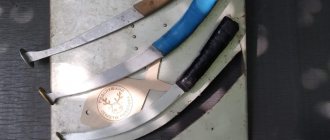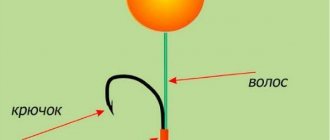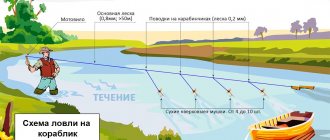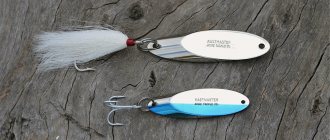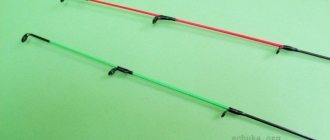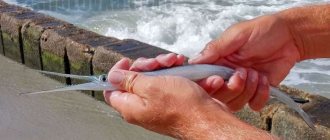Construction and materials
The fly is made using various feathers, hair from wild and domestic animals, multi-colored threads, synthetics and other materials. As a rule, it is crocheted directly onto a hook.
The design of a particular fly, as a rule, depends on its type, the intended object of fishing and the insect being simulated.
I. Wet flies:
- wingless (hackle wet flies): spider (spider), beetle (beetle), caterpillar (palmer);
- with wings (winged wet flies): mayfly (dun, spinner), caddisfly (sedge, caddis), butterfly (moth), May mayfly (may dun);
- nymphs;
- streamers. Popular in this group are muddler, matuka, bucktail, fly minnow, as well as flies tied from marabou feathers;
- flies used for catching sea and lake trout (lake and sea trout flies);
- salmon flies (salmon wet flies). In this group, some types can be distinguished: classic (regular), flies adapted for fishing at low water levels (low water), monoplane, Irish salmon flies;
- special baits for catching salmon and brown trout: Dee Lure, Norsk Lure, Demon, Terror, Worm Fly.
II. Dry flies :
- wingless (hackle floating flies): spider (dry spider), beetle (beetle), caterpillar (palmer), bivisible;
- with single wings (winged dry flies) or with double wings (doublewinged dry flies): mayfly (dun, spinner), caddis fly (sedge, caddis), butterfly (moth), may mayfly (dry may dun).
For wet fly fishing flies, the characteristic features are soft legs and wings laid along the fore-end.
Dry flies for fly fishing, on the contrary, should have stiff legs. This provides the fly with buoyancy. The main material for the legs is the feathers of roosters and chickens. The hard, glassy feathers of roosters are used to make dry flies, and the soft, less fatty feathers of chickens are used to make wet flies.
The method of tying the wings of a dry fly is determined by the type of insect being simulated (mayfly, caddis fly, etc.) at a certain stage of its life. Regarding the body of the fly, especially when wet, it is necessary to remember that some materials may change color when wet.
When tying fly fishing flies, it is necessary to observe not only the sizes of natural prototypes, but also certain proportions. The tail of the fly should not exceed the length of the hook (except for mayflies and spinners). The wings should be slightly longer than the length of the hook shank. The legs should be either at the level of the hook tip or slightly extend beyond it (spinners have legs almost twice this size).
The hook on which the fly is tied should be elastic, should not break, and should bend under significant tension. Sufficient sharpness of the hooks should be a prerequisite when purchasing them.
Knitting tools
Now you have accumulated a lot of experience and, having acquired a high-quality set of tools and materials, you will be able to repeat the author’s developments according to the description.
I think that if you decide to take up professional fly tying, you should definitely buy tools. They are not cheap, but you will have your own unique lures. These tools have become available to a wide range of fly fishing enthusiasts not so long ago.
Knitting tools
Knitting tool set includes:
- A vice or vise is needed to secure the hook on which you will tie the body of the insect.
- Mounting thread.
- Knot twister.
- Scissors.
- Pen clips.
And this is not all accessories listed.
Operating principle
A fly is an artificial fishing bait. Used for vertical fishing, bombarding, spinning, with a boat, but most often for fly fishing. Once upon a time, fly fishing used exclusively live insects as bait. Nowadays, making a fly for fishing has become a kind of art. How many of them have already been manufactured and tested for catchability. Modern fly fishing fly collections include thousands of different models.
Fly fishing flies imitate the food that fish look for in the layers of water, between the bottom and the surface. But the angler should not focus only on fishing at the surface of the water with a floating line on a dry fly. Fish are in this layer only ten percent of the time. To master the remaining ninety percent of the reservoir, anglers need to study the whole variety of fly models for fishing at different depths.
Types and forms
Flies for catching fish are distinguished by the shape of an imitation of its natural food.
- Dry flies . These fly fishing flies imitate insects that find themselves on the water surface. These are mainly imitation of mayflies, dragonflies, gadflies, adult caddis flies, beetles, wasps and other flying insects. Fishing with this type of fly is carried out above the surface of the water.
- Wet flies . These fish-catching fly flies imitate tadpoles, fry, water bugs, leeches, bedbugs and drowned insects
Also, individual forms of flies are often distinguished into species:
- Nymphs . These baits imitate the underwater stage of insect development. From the moment the female lays eggs under water, the larvae emerge from them, and right up to the beginning of the transition to the next stage. Fishing with a “nymph” fly occurs at the very bottom. Often such flies are surrounded with lead or tungsten heads.
- Emergers . When the nymph is ready to move on to the next stage of development, it rises to the surface and freezes before hatching. Then, the insect breaks through the film and enters the adult stage. Fly fishing flies that imitate the moment of metamorphosis are called emergers.
- Streamers. These lures imitate fry and are used to catch large fish. These are the heaviest and largest fly fishing flies. They are equipped with tungsten or steel, which, when wiring, allows you to imitate the behavior of a wounded or sick fish. To deliver such streamers, a triple cast “from water to water” is used without playing in the air.
- Salmon fishing flies . They imitate small fish that Atlantic and Pacific salmon eat when entering the river. Most flies for catching salmon are fancy, they have a bright color, provoking this fish to bite.
- Sea flies . Fly fishing flies for fishing in salt water. They imitate marine invertebrates - shrimp, crabs, worms and small fish. These are the largest of the fly fishing flies, their length can reach thirty centimeters.
According to the degree of imitation of living organisms, flies differ:
- realistic - depicting a simulated insect with a high degree of similarity;
- imitation (stencil) - imitating the most important proportions and shapes of an insect or group of insects;
- fantasy flies (attractors) - have no prototypes in living nature. They provoke the fish to grab out of curiosity, the instinct of protecting the territory, or aggression;
- decorative or frame flies. Flies knitted from rare or expensive materials and not intended for fishing. “Frame” flies are demonstrated at exhibitions and knitting competitions, sold and made to order for collections.
How to tie your first fly
In any case, to knit, you must have your hands free to carry out the manipulations. Therefore, secure the hook in a small vise or jaws, and, in turn, clamp them in a larger vise.
You will knit on the shank of the hook. Start from the middle of the hook bend. First, wind the crochet thread tightly in two rows along the shank. It is easier to glue and attach feathers and other elements to this base. Take a bird feather, a smaller one, which is located on the neck and sides, and tie it to a hook with thread. As a result, the body of the hook will be hairy. To prevent the thread from unraveling, it is secured with special knots. The insect's head is also made from knitting thread. Take a larger and stiffer feather and wrap it perpendicularly, these will be the wings. Cut off any excess with scissors. Don't forget to tie on the tail for the fly. The tail serves as a guide for the fish to bite. The tail can be a piece of woolen thread.
Flies are not white, so they use different colored tying thread and different feathers. White feathers can be painted with aniline dyes. The fish reacts very much to various shiny threads.
Technique
There are two main casting techniques used: regular and power.
A typical cast consists of three stages: backswing, line extension and forward swing. The success of the entire throw depends on the first stage, the importance of which many recklessly underestimate. The swing must be done quite strongly, using the rod you need to lift the line and throw it back. Initially, only the forearm is involved in the lifting; the hand joins only in the last stages. You need to finish it strictly with the rod in a vertical position. Now you need to stop and wait until the cord is completely straightened, after which you extend the cord and swing forward in the same way. The rod should move in a straight line. It should be stopped in the clockwise position at 4 hours 30 minutes.
The cord is lengthened before the forward swing begins. To do this, before you start casting, you need to grab the cord directly next to the reel with two fingers of your left hand and unwind a small amount of it and place it between your hand and the drum and hold it in this position while making a backswing. When the cord is almost completely straightened, the section held by your fingers should be released.
To improve your casting technique, it is recommended to perform the following exercise. First, blank casts are performed. A back swing is made, then a forward swing, after which, without allowing the fly to come into contact with the water, you should again proceed to the back swing. Idle casts continue until the height of the forward swing reaches head level. Then you should move on to extending the cord. During the back swing, which is carried out with the right hand, two fingers of the left hand need to grab the cord near the drum and release a small section of it from the spool. At the moment of complete straightening of the cord before the forward swing, the section of it grasped by the fingers of the left hand must be released, and the remaining part must be fixed again to the rod with the freed left hand. You need to make several casts with extension until the fly touches either the ground on the back swing or the water on the forward swing.
Power casting is used to achieve maximum range. In this case, additional acceleration can be given to the cord by lengthening the line in the manner described above, both when swinging forward and when swinging backward.
If there is not enough space behind for a full backswing, use side or ring casts. The first one is practically no different from a regular overhead cast. The only peculiarity is that the fishing rod moves in a horizontal plane. To make a ring cast, the fishing rod is slowly raised to the clockwise position at 2 o'clock, after which a forward swing is performed. In this case, a ring rolling forward should form on the cord.
Casting with a two-handed rod is done in almost the same way as with a one-handed one. The only peculiarity is that it is impossible to extend the line with your left hand; it must always be located on the butt of the rod. The free loop of the cord for extension is placed on the segment between the right hand and the reel. You need to release the cord just before it straightens when swinging forward. The casting rhythm when using a two-handed rod is slower compared to a one-handed one.
Tactics
Fly fishing is effective during the period of time when fish rise en masse to the surface of the water. For example, in the summer, when it actively feeds on insects, or in the first days of the spring thaw, when only the upper layers of water warm up. It’s good to fish in a wade this way, especially with a small wave or fast current. An important condition for successful fishing is the ability to cast a fishing rod correctly. It is necessary to smoothly place the fly on the water, and it should come into contact with the water before the reins and fishing line. Casting accuracy is no less important. Good skills can only be mastered through systematic training. First, the exercises are performed on a special platform with obstacles, and then they are moved to the water.
There are two options for fishing: with a dry fly and with a wet one, as well as bottom fishing with a nymph. In the first case, the casting location is chosen based on the splashes of the fish, the casting itself is carried out from the knee, and the bite is assessed by eye. In the second case, the fly is allowed to sink completely into the pond, after which it must be constantly pushed, because the fish actively bites only on a moving bait.
What is a front sight
A fly is one of the types of artificial baits, which is a fairly realistic imitation of the favorite insects of predatory and peaceful categories of fish.
It shows its high efficiency at the end of spring and at the beginning of summer, when representatives of the ichthyofauna become hungry and they practically rush to any offered bait. especially in demand among predators who prefer live food. An insect that has fallen into the water begins to make every attempt to get out, eventually its wings become wet, heavy, and it dies. The bait imitating it should also behave in a similar way. The more believable the fly game is, the greater the chances of catching the coveted trophy.
Based on this, casting the bait should be accompanied by movement; if the water flow at the fishing point is weak, then you will need to tug the line a little. This simple technique allows you to activate potential prey and provoke it to capture an artificial insect.
In most cases, flies are made from natural material, including fur and feathers, but versions made from synthetic fibers are also quite successfully practiced. Here everything depends on the object of fishing. In the warm season, perch becomes a frequent prey, but in late autumn - pike perch. Starting from mid-summer, catching asp will be an effective hunt, but in order to attract it, it is necessary to equip the tackle with two or three baits. On hot days, it is better to rely on a dry type of fly.
Kinds
Considering the variety of artificial insects, they can be classified into the following groups:
Example of a wet fly
Wet flies . This species is similar to the larvae of tailless amphibians, leeches, beetles, drowned insects and their larvae. A characteristic feature of flies is a thin body, the presence of legs, a tail and wings directed towards the sting. They are tied on a thick hook and used in fly fishing. This bait option is more suitable for catching asp, grayling, and salmon.
Dry flies . This is a type of invertebrate that has fallen into the water, such as the gadfly, fly, caddisfly, honeydew, dragonfly, etc. The bait shows itself worthily on the surface of the water, it is capable of going deeper. To make dry flies, hard bird feathers are used, which ensures that the bait stays only on the surface. Hooks made of thin wire material are more suitable for these purposes. The popularity of the bait is due to its versatility.
Streamers . The devices represent juvenile fish, fry, common in a particular body of water. The originality of the bait lies in the presence of a long wing, longer than the size of the hook itself. In addition, there is a body, a neck that looks like fins, scales in the form of a winding and bright, shiny components that significantly attract the attention of a predator, and a large one at that. The bait depicts a wounded victim, they tie it on a hook loaded with tungsten and steel. Such devices are heavy.
Streamer. Model Brush Streamer
Nymph
Emager
Fantasy front sight option
Nymphs . This variety is produced in both fantasy and natural versions. This is a plausible imitation of pupae, larvae - invertebrates at the stage of their development. In order for fishing to be as productive as possible, the color of the nymphs must match the nature of a particular body of water; the bait itself is tied on a hook, additionally equipped with lead wire. This artificial bait is in great demand among fly fishing enthusiasts.
Emergers . This is the most catchy fly for grayling, it is made in the form of an insect that is at the stage of transformation from a pupa to an adult. Even a passive predator cannot miss such bait.
Fantasy flies. This is a special type of device for attracting fish; they are distinguished by the lack of real prototypes. They are made exclusively based on the imagination of the fisherman himself, but taking into account the food preferences and behavior of the fish. Lures vary in color, size and shape. It is especially effective to make fancy flies when fishing for pike perch.
Tackle
Rod
The main component of the tackle for fly fishing is the rod, to which the reel and line are selected. Modern technologies make it possible to make fishing rods from carbon fiber. They are very good and precise in their work and do not require special care.
Fly fishing rods, or blanks, are usually divided into classes. As the class increases, the strength of the blank increases, and the rod is able to withstand greater loads.
Coil
A fly reel is a variation of the regular inertial reel. The reel in fly fishing gear is not involved in casting; it serves as a storage for line and backing and for landing caught fish.
Fly fishing reels are divided into three types:
- automatic;
- multiplier;
- ordinary.
Reels are classified according to rod classes, that is, for each rod you should select its reel class. Otherwise, the tackle will not be balanced, which will lead to poor casting and rapid hand fatigue.
Cord
The main difference between fly fishing and spinning is the principle of casting bait. When fishing with a spinning rod, the spoon flies forward and pulls the fishing line behind it, since it has considerable weight. In fly fishing, the mass of the fly is negligible, and casting it in this way would be impossible. Therefore, casting is carried out using a heavy and thick cord, which flies due to its own weight. A long shepherd's whip works in much the same way. Before casting, the line is “played out” - it is accelerated overhead by swings of the rod to give it the speed necessary for flight.
Cords are classified by class (the weight of the first 9 meters of the front part of the cord), by buoyancy, by geometry (shape), and purpose.



